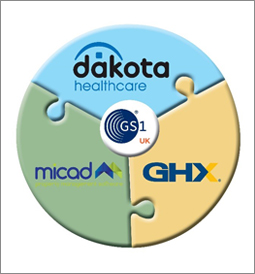September 12, 2016 Guest opinion piece
 A view from Geoff Monk, Head of Healthcare at Dakota Integrated Solutions.
A view from Geoff Monk, Head of Healthcare at Dakota Integrated Solutions.
The adoption of GS1 standards has revolutionised retail practice and helped drive productivity efficiencies and cost savings. But with £30billion of savings needed in the NHS by 2021 and the demographic time bomb ticking, it’s long overdue that the NHS followed suit.
In a trilogy of articles, we will look at the core enablers around which the Scan4Safety concept is based, helping you understand why NHS Trusts simply cannot afford NOT to implement and adopt GS1 standards.
As part of the eProcurement strategy set out by the Department of Health in 2014, GS1 standards are to be used for three core enablers - catalogue management, patient identification and location numbering. In other words, this means the unique identification of:
- every person
- every product
- every place
Being able to provide accurate information for every one of these areas is key to patient safety. In this article, we’ll take a closer look at the first core enabler – patient identification - with upcoming blogs in September and October taking a look at catalogue management and location numbering.
The correct identification of a patient is absolutely critical. There have been too many reported instances where patients have been misdiagnosed, given the wrong drugs or had the wrong surgery – and in rare instance this has even led to fatalities.
Reducing and, where possible, eliminating errors in the matching of patients with their care is central to improving patient safety in the NHS. There are three main types of error that can occur:
- a patient is given the wrong treatment as a result of a failure to match them correctly with samples, specimens or x-rays
- a patient is given the wrong treatment as a result of a failure in communication between staff or staff not performing checking procedures correctly
- a patient is given treatment intended for another patient as a result of a failure to identify him or her correctly
The patient wristband is key to the correct identification of a person. A few years ago when my wife was admitted into our local hospital I was horrified to discover that she had been given a hand written wristband! Fortunately, this is now a very rare occurrence, nearly all NHS Trusts comply with NPSA regulations and patients are now identified with a printed wristband. Often there also is a barcode on the wristband, however in many instances it is just “for show” and not fully utilised.
Scanning the barcode on the wristband has a direct correlation with reduced risk and improved patient safety. A 2D GS1 Datamatrix barcode (as mandated under ISB1077) is designed to hold all the key patient identifiers, including name, date of birth and NHS number. It also scans much more reliably than a standard linear barcode, especially on the curved surface of a wristband.

Example of patient wristband with GS1 compliant barcode
Just as important as physically identifying the patient at the point of care, is the need to create a full audit trail. A good example is the silicone breast implant scandal from a few years ago, where it proved extremely difficult to track down all affected parties. By utilising the barcode on the patient wristband, you will be able to scan the wristband, scan the implant, along with the location – giving you the vital audit information of patient, product, place and process.
The biggest challenge for the NHS now is to ensure this initiative doesn’t go out with a whimper. We need to buy into this and be enthused by the benefits that can be realised by implementing GS1 standards.
 The six demonstrator sites are already working towards fully adopting GS1 standards and looking forward to reaping the benefits highlighted in the recent Lord Carter Report – with a view to improving patient safety, improving efficiencies and saving money. The question is can other NHS Trusts afford not to follow?
The six demonstrator sites are already working towards fully adopting GS1 standards and looking forward to reaping the benefits highlighted in the recent Lord Carter Report – with a view to improving patient safety, improving efficiencies and saving money. The question is can other NHS Trusts afford not to follow?
For more information on how Dakota can help you implement GS1 standards, please e-mail nhs@dakotais.co.uk.
Dakota IS will be hosting a stand at EHI Live this year, in partnership with Micad, GHX and GS1 UK - register for your place.